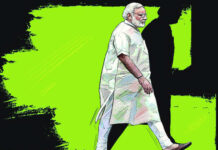To rescue the language, the first step would be to honour the history of Bhojpuri literature and then to include it in the Eighth Schedule of the Constitution.
Adesperate attempt is on to “rescue” Bhojpuri, a language of crores in Bihar and Uttar Pradesh, from the clutches of “vulgarity”. In June, an FIR was lodged against popular Bhojpuri singer Khesari Lal Yadav. In the complainant, the head of a religious body in Mumbai found his songs “obscene and vulgar”. That same month, parliamentarian Ravi Kishan wrote a letter to the Ministry of Information and Broadcasting and the state governments of UP and Bihar seeking a ban on vulgar content in Bhojpuri films. He assured the dissident public that he would raise the issue in Parliament.
But is that all Bhojpuri needs? Traditional wisdom tells us that a living language — one spoken and sung by communities — can never die. That is the classic Sanskrit conundrum. But the Bhojpuri language defies this linear reasoning. Sung and celebrated by the masses, and yet in free-fall, Bhojpuri doesn’t need to be saved from death. It needs concerted intervention to elevate. A language can die in many ways even when it remains alive. That’s what the experience of Bhojpuri in recent decades tells us.
While action can be taken against the content creators, the language does not require police protection — it requires state protection, which it never had. This historical oversight led Bhojpuri literature into ignominy and the vacuum was filled with vulgar songs, simply because they are easy to write.
To “rescue” the language, the first step would be to honour the history of Bhojpuri literature and then include Bhojpuri as a language in the 8th schedule to the Indian Constitution because, in the world of social media, endorsement is everything. And what bigger endorsement can a language get, than being recognised by the Constitution?
History of Bhojpuri, the language
According to author Krishnadev Upadhyaya, who wrote ‘Bhojpuri Lok Sahitya ka Adhyayan’ (1960), Bhojpuri is one of the three bolis (dialects) of ‘Bihari bhasha’ along with Maithili and Magahi. The ‘Bihari bhasha’ was first defined by George A. Grierson, an Irish Indian Civil Service officer who was posted in Bihar during the British rule, and had interest in philology and linguistics. In those times, Bhojpuri was mainly spoken in the region between Kashi and Magadh, where Grierson worked. Upadhyaya further traces the history of Bhojpuri to when the descendants of Ujjaini kings from Malwa came to settle in Buxar–Ara region. They named its capital Bhojpur after the great Ujjaini king Bhoj and thus the boli came to be known as Bhojpuri.
Upadhyaya describes Maithili and Magahi as Bhojpuri’s two ‘sagi’ (immediate) sisters and Bengali, Assamese and Odiya as three female cousins, indicating that all these languages belong to the same group. However, in medieval times, Bhojpuri couldn’t get a poet such as Vidyapati in Maithili, and Chandidas in Bengali. Though the verses of Kabir Das contained Bhojpuri words, it was not primarily Bhojpuri literature.
Thus, Bhojpuri remained the bhasha of commoners and expressed itself in the Indian culture through simple-worded poems and songs. It meandered into every strata and strand of life. There is a Bhojpuri poem and song for everything: khel like Gilli Danda, the sanskaras of life such as birth, marriage; for different stages of farming; for various weathers chaita, fagun, and sawan; for thebfestivals like holi, pidiya, teej; and also sometimes according to the cultures of caste groups like biraha and pachra.
In some communities, while administering medicines to patients, pachra songs and dances were performed. However, there is little work documenting these cultures.
Bhojpuri does have a history of being used as gadya, that is, prose for legal work in the 17th century. The one danpatra (donation) record, which Upadhyaya cites, dates back to 1735 and another affidavit dates back to 1796 in the name of a local king, Udwant Singh. ‘Udwantnagar’ village in Ara district of Bihar is named after him. Renowned freedom fighter of the 1857 independence struggle, Veer Kunwar Singh, was his great-grandson.
Development of Bhojpuri literature
One hundred years ago, in the early 20th century, the dormant Bhojpuri literature bloomed and found its two stars. One was a romantic ghazal ‘Badmash Darpan’ (Wicked Mirror) written by legendary Teg Ali Teg. The other was a revolutionary anti-caste poem, published in Hazari Prasad Dwivedi’s Saraswati magazine and written by Hira Dom, a poet from the lowest rung in the caste hierarchy. However, the real lives of both these star writers remain shrouded in mystery.
Teg Ali Teg writes sufistic verses in Badmash Darpan:
जानी ला आजकल में झनाझन चली राजा,
लाठी लोहांगी खंजर औ बिछुआ तोहरे बदे
I know that for you Raja (my love), there is going to be a battle in which sticks and knives will be used.
कासी पराग द्वारका मथुरा औ वृन्दावन
धावल करैलें ‘तेग’ कन्हैया, तोरे बदे.
Teg keeps running from Kashi, Prayag, Dwarka to Mathura and Vrindavan for you, O Kanhaiya.
If there is ever a ghazal to have been written in a Benarasi style, then it is in Badmash Darpan. It is full of fun, taunts, bravado and love. Its many verses allude to Shiva, Krishna and other Hindu gods. There are many stories related to the legend of Teg Ali. In some, he is allegedly called ‘Kashi ka Goonda’, which makes his ghazals more interesting.
There is said to have been a Gunda community in Benaras post the Mughal era. In the story ‘Kashi ka Gunda’ by one of the greatest Hindi writers, Jay Shankar Prasad, the hero — Babu Nanhku Singh — has a lifestyle that closely resembles Teg Ali Teg’s.
Bhojpuri literature got a new lease of life after Ali Teg when M.K. Gandhi joined the freedom struggle. Many poems were written in Bhojpuri to spread Gandhi’s message. These poems played an important role in arousing a nationalistic sentiment. There were poems on the impact of the First World War, the Jallianwala Bagh massacre, the 1934 Bihar-Nepal earthquake, and the Second World War. The poems talked about revolutionaries, the pathetic situation of Indian women and about the assassination of Gandhi.
Bhojpuri writers did not focus only on local issues but had their eyes on global developments as well. In 1942, writer Rahul Sankrityayan wrote a play predicting the defeat of Hitler’s Germany. The play had two main characters: Bhasundi, who claimed that no one has slept hungry in Germany since Hitler came to power, and the Gharbharan/Ramsubhag, who argued that Germany was being destroyed step-by-step under Hitler.
Bhojpuri literature’s revolution, however, came with the playwright Bhikhari Thakur (1887-1941), who introduced socio-progressive elements to its register. Called the ‘Shakespeare of Bhojpuri’ for the dramatic and emotional impact of his plays, Thakur was famous for his Bidesia dramas. Play and theatre artist Satish Anand has compared Thakur’s Gabarghichor to Bertolt Brecht’s The Caucasian Chalk Circle for its subject matter. Thakur’s talent spread beyond playwriting into other aspects of literature. Echoing the intensity of Urdu poets, he wrote about himself:
नाम भिखारी काम भिखारी, रूप भिखारी मोर.
टाट पलानि मकान भिखारी, चहुंदिसि भइस सोर.
My name is Bhikhari (beggar), my work is Bhikhari and my face is like that of a Bhikhari. My house is that of a Bhikhari, worse than a hut. And my story is quite popular everywhere.
The struggles of Bhojpuri language and literature
The real challenge for Bhojpuri came after India’s Independence, when it couldn’t get a place in the esteemed 8th Schedule of the Constitution. It remained the language of Bihari migrants, who, even then, worked in different parts of undivided India. For others, it was a small matter, but for the Bhojpuri-speaking people, it was a matter of pride because its sister languages Maithili, Bengali, Odiya and Assamese had received constitutional recognition. In 1971, Communist Party of India (CPI) MP Bhogendra Jha brought a bill to Parliament for Bhojpuri to be listed in the 8th Schedule but it was rejected.
The struggle to establish Bhojpuri as a literary language like its sister languages is also very old. Before Independence, Uday Narayan Tiwari worked tirelessly for the cause of the Bhojpuri language, compiling its grammar and history in his seminal works – The Origin and Development of Bhojpuri and Bhojpuri Bhasha Aur Sahitya. Thanks to him, Bhojpuri now had a history, grammar, and literature, but it still did not have the state patronage, which had a negative impact. Not being recognised as an official language was sufficient for its literary world to crumble. However, the writers made an effort to keep passing the baton.
After Independence, a Radio drama in Bhojpuri named ‘Loha Singh’ written by Rameshwar Singh Kashyap became one of the most popular Bhojpuri works during the Sino-Indian War of 1962. In it, a retired soldier returns to his village and tries to reform his society. Its humorous and mixed Hindi-English-Bhojpuri dialogues became quite popular among the masses. In his biography ‘Gopalganj to Raisina’, former Bihar Chief Minister Lalu Prasad Yadav fondly remembers its dialogues.
From 1947 to 1975, many novels were written in Bhojpuri such as Bindia, Tharuhat ke Babua aur Bahuriya, Semar ke Phool, Rahanidaar Beti, Ego Subah Ego Saanjh and Sunnar Kaka. Later, a few more were published between 1975 and 2020 like Phoolsunghi, Ghar Tola Gaon, Jinigi ke Raah, Darad ke Dahar, Achhoot, Imiritiya Kaki, Amangal Hari, Adhe Aadh, Kadambari, Daal Bhaat Tarkari, Botaldas Ke Bayaan and Ganga Ratan Bidesi.
Interestingly, most of these novels focus on social issues such as family relationships, love, marriage, the caste conundrum and the rights of women but follow the pre-independence ace Hindi writer Premchand’s style.
However, they remained largely untouched by the Progressive Writers’ movement, the Naxal movement of Bhojpur, the Emergency, liberalisation and globalisation and the advent of the Internet, which could have been the trigger for the creation of new literature.
A reason for that may be that there was no revolutionary intellectual such as Babasaheb Ambedkar or Periyar in this region who could challenge the social norms. Perhaps the fact that Bhojpuri couldn’t be the medium of education could have also meant that it couldn’t attract the new generation. Bhojpuri literature also remained confined to the clutches of the rigid caste system. Still, one should appreciate the intent of idealism shown in the early Bhojpuri novels.
Vulgar songs and the way forward
The real fall for the Bhojpuri language came after the age of liberalisation in the ’90s when many cassette companies appeared in the music field. Bhojpuri songs became a hit and had a potential audience base of around 12 crore.
The lack of education among the masses and the fact that Bhojpuri was also not the medium of education, rendered traditional poems and songs obsolete. The literary prowess was quickly overpowered by the youthful adventure of new singers and writers, which gradually descended into vulgarity.
In order to get more hits by titillating the masses, the songwriters wrote more vulgar songs.
Vulgarity became a measure of success. There was nothing in modern Bhojpuri literature that could prevent this free fall and create something progressive. Further, with the advent of the Internet, Bhojpuri bhasha got its new identity in the 21st century: auto-tuned music with vulgar lyrics. All efforts to create good songs have gone under the radar because of the overwhelming demand for vulgarity.
On the other hand, due to the Internet penetration and the constant need for social media for localised content, a new focus is being given on vernacular languages, so the future may not be all bleak. Recently, the novel Phoolsunghi (1977), a story about the love affair between a Bhojpuri poet Mahendra Misir and a courtesan Dhelabai, was translated to English and published by Penguin in 2020. It was well-received on social media.
Now to expedite the process, all that’s needed is state patronage, which may energise the dormant Bhojpuri world. Perhaps then, new literature will emerge and be recognised for its richness.
Vulgarity, one hopes, would be replaced by the sweetness of Bhojpuri literature. After all, such is the sweetness of this language that even ‘Kashi ka Goonda’ started writing ghazals. #livehyd #LiveHyd







